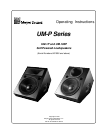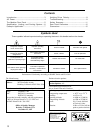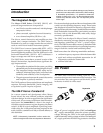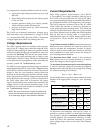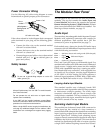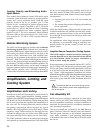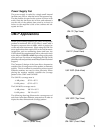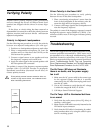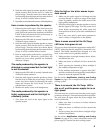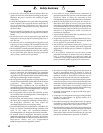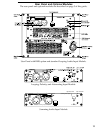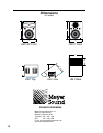
&
Verifying Polarity
Incorrect driver polarity impairs system performance
and may damage the drivers. All Meyer Sound loud-
speakers are shipped with the drivers in correct align-
ment.
If the driver or circuit wiring has been removed or
disassembled it is essential to check the polarity between
adjacent monitors and between drivers and between
adjacent loudspeakers.
Polarity in Adjacent Loudspeakers
Use the following test procedure to verify the polarity
between two adjacent loudspeakers of the same type:
1. Position two loudspeakers adjacent to each other.
2. Place a measurement microphone 3ft. from the
speakers and 3 to 4 feet above the UM-1Ps, on the
axis between the speakers.
3. Connect a signal source to one speaker and note
the frequency response and overall level.
4. Apply the same signal to the second speaker with
the first speaker still connected.
The polarity is correct if the frequency response remains
constant with a 5-6 dB SPL increase in amplitude.
Broadband cancellation (decreased overall level) in-
dicates polarity reversal.
Since polarity reversal causes excessive driver ex-
cursion at high source levels, use moderate levels
when conducting these tests.
Driver Polarity in the Same UM-P
Use the following test procedure to verify polarity
between drivers in the same loudspeaker:
1. Place a monitoring microphone 1 meter from the
front of the loudspeaker at the midway point be-
tween the high and low frequency drivers.
2. Connect a full range signal to the loudspeaker and
note the frequency response.
The polarity is correct if the frequency response is smooth
through the crossover region (800Hz to 1.5kHz). Can-
cellation of 6dB or more in this region indicates polarity
reversal.
Troubleshooting
This section suggests several possible solutions to some
common problems encountered by UM-P users and is
not intended to be a thorough troubleshooting guide.
Qualified electronics technicians with access to a test
bench can request the following documents from Meyer
Sound: Troubleshooting Guide, The Low Frequency
Driver Replacement Procedure, and The High Frequency
Driver Replacement Procedure for the UM-1P/100P.
The On/Temp. LED does not illuminate,
there is no audio, and the power supply
fan is off.
1. Make sure the AC power cable is the correct type
for the regional voltage and that it is securely
connected to the AC inlet then unplug and recon-
nect the AC cable.
2. Use an AC voltmeter to verify that the AC voltage
is within the ranges 88–264V, 47–63 Hz.
3. Call Meyer Sound Technical Support.
The On/Temp. LED is illuminated but there
is no sound.
1. Verify that the audio source (mixer, EQ, delay) is
sending a valid signal.
2. Make sure the XLR cable is securely fastened to the
XLR audio input connector.
3. Verify that the XLR cable is functioning by substi-
tuting another cable or by using the cable in ques-
tion in a working system.
!
UM-P
Reference
UM-P
Under Test
3 Feet



